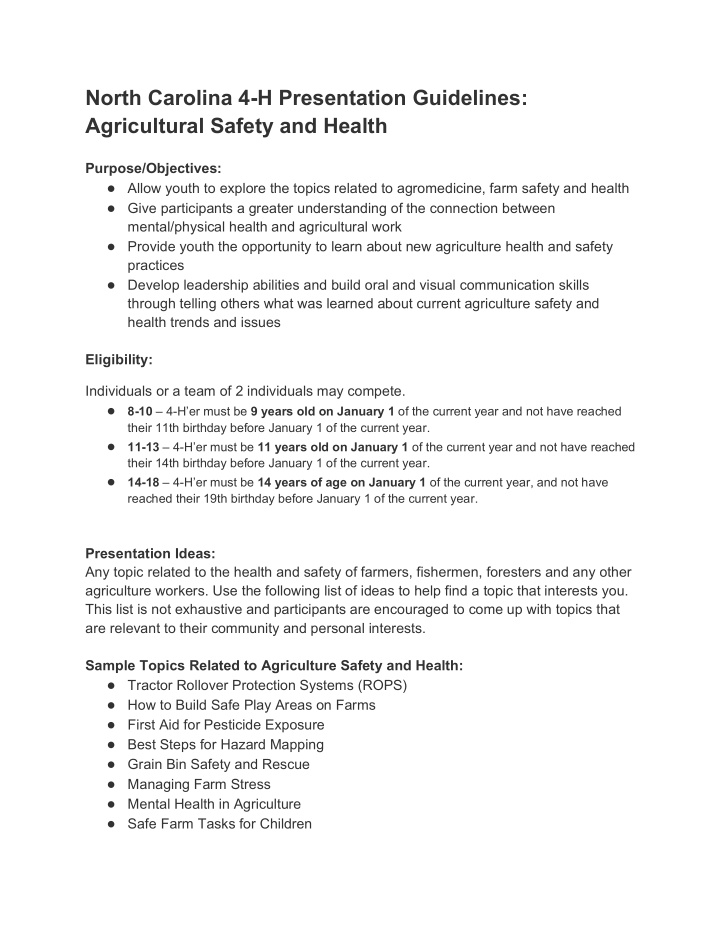



North Carolina 4-H Presentation Guidelines: Agricultural Safety and Health Purpose/Objectives: ● Allow youth to explore the topics related to agromedicine, farm safety and health ● Give participants a greater understanding of the connection between mental/physical health and agricultural work ● Provide youth the opportunity to learn about new agriculture health and safety practices ● Develop leadership abilities and build oral and visual communication skills through telling others what was learned about current agriculture safety and health trends and issues Eligibility: Individuals or a team of 2 individuals may compete. ● 8-10 – 4-H’er must be 9 years old on January 1 of the current year and not have reached their 11th birthday before January 1 of the current year. ● 11-13 – 4-H’er must be 11 years old on January 1 of the current year and not have reached their 14th birthday before January 1 of the current year. ● 14-18 – 4-H’er must be 14 years of age on January 1 of the current year, and not have reached their 19th birthday before January 1 of the current year. Presentation Ideas: Any topic related to the health and safety of farmers, fishermen, foresters and any other agriculture workers. Use the following list of ideas to help find a topic that interests you. This list is not exhaustive and participants are encouraged to come up with topics that are relevant to their community and personal interests. Sample Topics Related to Agriculture Safety and Health: ● Tractor Rollover Protection Systems (ROPS) ● How to Build Safe Play Areas on Farms ● First Aid for Pesticide Exposure ● Best Steps for Hazard Mapping ● Grain Bin Safety and Rescue ● Managing Farm Stress ● Mental Health in Agriculture ● Safe Farm Tasks for Children
● Working Youth in Agriculture ● Mobile Healthcare for Fishermen ● Logging Hazards ● Field Hygiene and Hand-washing ● History of the NC Agromedicine Institute ● Farmer’s Lung Health Condition ● Respirator Fit-Testing ● Cold/Heat-Related Illness ● Safe Handling of Livestock ● Zoonotic Disease ● Health Benefits of Farm Life ● PTSD Veteran Farmers ● Assistive Farm Technology ● Safety and Agritourism ● Farming Ergonomics Rules/Regulations: See NC 4-H Rules and Regulations 8-10 Scoresheet 11-13 Scoresheet 14-18 Scoresheet Resources : NC Agromedicine Institute Email: agromedicine@ecu.edu Website: www.ncagromedicine.org NC State Extension Agromedicine Farm Safety Website Website: www.farmsafety.wordpress.ncsu.edu NC Agrability Program Email: Dr. Crystal Kyle, Program Director, cakyle@ncat.edu Website: www.ncagrability.org Marshfield Clinic Research Institute Email: webmaster@mcrf.mfldclin.edu Website: www.marshfieldresearch.org
Other Resources: Ag Injury News Online Database: www.aginjurynews.org AgriSafe Network Website: www.agrisafe.org Center for Disease Control and Prevention Website: www.cdc.gov Cultivate Safety Website: www.cultivatesafety.org eXtension Ag Safety and Health Webpage: https://ag-safety.extension.org/ National Agriculture Safety Database Website: http://www.nasdonline.org/ National Children’s Center for Rural and Agricultural Health and Safety Website: https://www.marshfieldresearch.org/nccrahs NC State Extension Agromedicine Dictionary: www.agromedicinedictionary.ces.ncsu.edu NIOSH Agriculture Safety Website: https://www.cdc.gov/niosh/topics/aginjury/default.html Progressive Agriculture Foundation: https://www.progressiveag.org/ Southeast Center for Agricultural Health and Injury Prevention: https://www.uky.edu/scahip/ Suggestions/Helpful Hints: ● Pick a topic that is specific and can be covered in 8-12 minutes. ● Choosing more general topics often results in too much information covered at too fast of a speed. ● Choose a few key points and center information around them. ● Speak directly to the audience and avoid reading from a script. ● Use an outline, posters, and demonstration materials to guide the audience through the presentation. ● Relax and have fun!
Writing Tips The presentation should have a distinct format in order to help the audience follow what you are saying. This format includes an introduction, the body of your speech, and a concluding statement. ● In the introduction , capture the audience’s attention by sharing a story related to your topic. Also be sure to introduce yourself and share why the chosen topic is important. It’s also good to include a preview of your main points. ● The body of the speech will include (2-4) main points and the bulk of your information. Follow the “magic formula” to discuss this information, including point, support, and application. ○ Point: Clearly state the main idea you’re sharing ○ Support: Provide facts, stories, personal experience or other information that supports your main point ○ Application: Relate this information to real-life. How can it be used by people in your community? ● The conclusion should summarize the information you have shared into a few sentences. In your conclusion, you may want to refer back to the story you shared in your introduction or challenge the audience to action. Awards: Sponsored by the National Children's Center for Rural and Agricultural Health and Safety and the NC Agromedicine Institute Prizes will be awarded to 3 age categories. Awards will include gold, silver and bronze at the 5 district and state level contests. Prize amounts include: ● District Gold= $150 ● State Gold=$200; State Silver= $150, State Bronze=$100 Specialist: Alyssa Spence Email: arramsey@ncsu.edu Phone: 828.380.1327
Recommend
More recommend